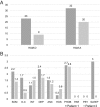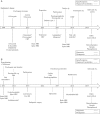Pseudoagoraphobia, a Diagnostic Clue in Stiff-Limb Syndrome
- PMID: 32258231
- PMCID: PMC7111565
- DOI: 10.1002/mdc3.12911
Pseudoagoraphobia, a Diagnostic Clue in Stiff-Limb Syndrome
Abstract
Background: Stiff-limb syndrome is part of stiff person spectrum, presenting with fluctuating gait disorders attributed to leg stiffness, spasms, and posturing. It could also manifest with anxiety and specific phobias such as pseudoagoraphobia. We aimed to describe the importance of specific gait phobia as a diagnostic clue to anti-glutamic acid decarboxylase stiff-limb syndrome.
Cases: We reported on 2 cases of stiff-limb syndrome sharing a similar diagnostic path and phenomenology. Both were featured by pseudoagoraphobia, which has documented to typically cover organic conditions, and a remarkable diagnostic delay attributed to misdiagnoses. Presence of pseudoagoraphobia should not point to the diagnosis of a functional disorder-although a negative instrumental workup is documented.
Conclusions: Both cases are emblematic of the high misdiagnosis rate affecting stiff person syndrome patients. A proper diagnostic process, including the identification of a pseudoagoraphobia, should help in reaching a diagnosis and providing an early and effective treatment.
Keywords: anti‐GAD antibodies; functional movement disorders; gait; spasticity; stiff man syndrome.
© 2020 International Parkinson and Movement Disorder Society.
Figures


Similar articles
-
Anti-glutamic acid decarboxylase 65: Related stiff person syndrome - A report of two cases and literature review.SAGE Open Med Case Rep. 2025 Apr 29;13:2050313X251333676. doi: 10.1177/2050313X251333676. eCollection 2025. SAGE Open Med Case Rep. 2025. PMID: 40308378 Free PMC article.
-
Review of 23 patients affected by the stiff man syndrome: clinical subdivision into stiff trunk (man) syndrome, stiff limb syndrome, and progressive encephalomyelitis with rigidity.J Neurol Neurosurg Psychiatry. 1998 Nov;65(5):633-40. doi: 10.1136/jnnp.65.5.633. J Neurol Neurosurg Psychiatry. 1998. PMID: 9810930 Free PMC article.
-
Specific phobia is a frequent non-motor feature in stiff man syndrome.J Neurol Neurosurg Psychiatry. 2003 Apr;74(4):462-5. doi: 10.1136/jnnp.74.4.462. J Neurol Neurosurg Psychiatry. 2003. PMID: 12640064 Free PMC article.
-
Clinical Spectrum of Stiff Person Syndrome: A Review of Recent Reports.Tremor Other Hyperkinet Mov (N Y). 2016 Mar 4;6:340. doi: 10.7916/D85M65GD. eCollection 2016. Tremor Other Hyperkinet Mov (N Y). 2016. PMID: 26989571 Free PMC article. Review.
-
SPS: Understanding the complexity.J Neurol Sci. 2019 Sep 15;404:137-149. doi: 10.1016/j.jns.2019.06.021. Epub 2019 Jul 17. J Neurol Sci. 2019. PMID: 31377632 Review.
Cited by
-
Treatable Hyperkinetic Movement Disorders Not to Be Missed.Front Neurol. 2021 Dec 1;12:659805. doi: 10.3389/fneur.2021.659805. eCollection 2021. Front Neurol. 2021. PMID: 34925200 Free PMC article. Review.
References
-
- Nonnekes J, Goselink RJM, Růžička E, Fasano A, Nutt JG, Bloem BR. Neurological disorders of gait, balance and posture: a sign‐based approach. Nat Rev Neurol 2018;14:183–189. - PubMed
-
- Balint B, Bhatia KP. Stiff person syndrome and other immune‐mediated movement disorders—new insights. Curr Opin Neurol 2016;29:496–506. - PubMed
-
- Saiz A, Graus F, Valldeoriola F, Valls‐Solé J, Tolosa E. Stiff‐leg syndrome: a focal form of stiff‐man syndrome. Ann Neurol 1998;43:400–403. - PubMed
Publication types
LinkOut - more resources
Full Text Sources

